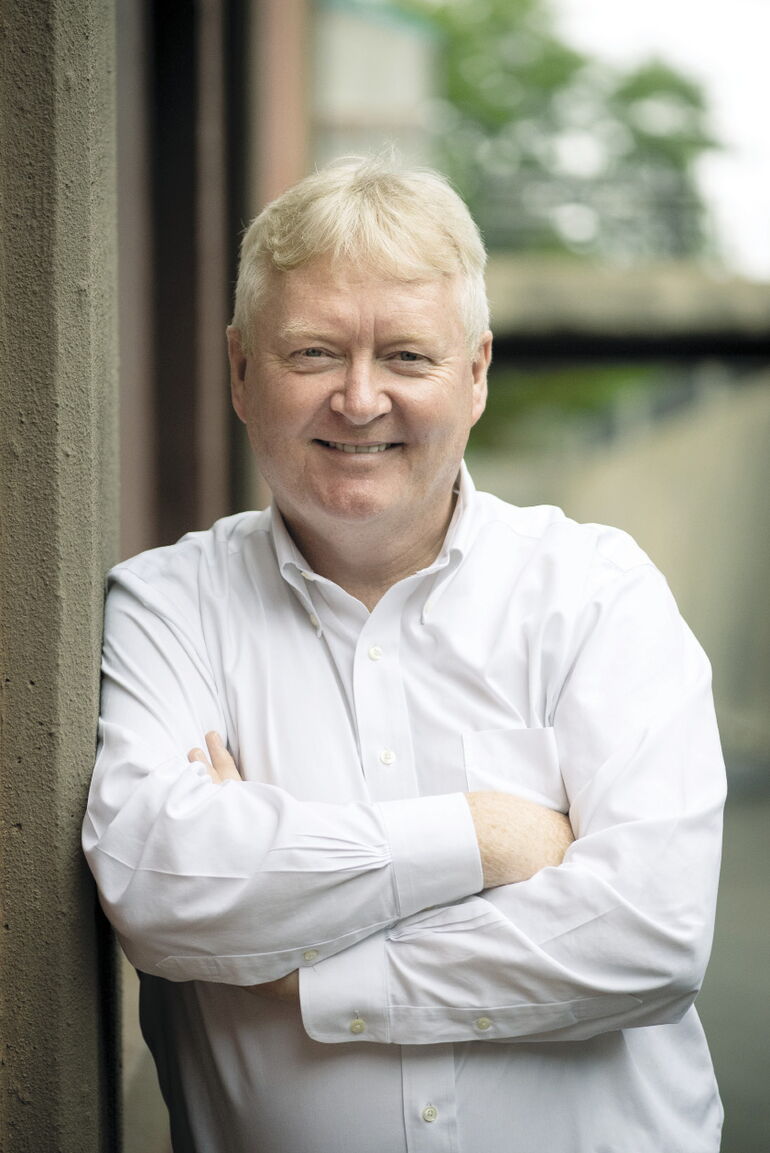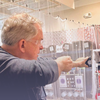
Processing Your Payment
Please do not leave this page until complete. This can take a few moments.
- News
-
Editions
View Digital Editions
Biweekly Issues
- May 13, 2024
- April 29, 2024
- April 15, 2024
- April 1, 2024
- March 18, 2024
- March 4, 2024
- February 19, 2024
- February 5, 2024
- January 22, 2024
- + More
Special Editions
- Lists
- Viewpoints
- HBJ Events
- Business Calendar
- Custom Content
Growing biotech Arvinas makes big bet on New Haven
 PHOTO | CONTRIBUTED
John Houston
PHOTO | CONTRIBUTED
John Houston
New Haven-based biopharmaceutical company Arvinas is making strides toward developing treatments for deadly ailments such as cancer and Alzheimer’s disease.
According to the company, its protein degraders harness the body’s natural protein disposal system to eliminate disease-causing proteins.
Yale University scientist Craig Crews founded the company in 2013, and Arvinas is building upon Crews’ research.
Arvinas’ two leading oral drug candidates, ARV-110 and ARV-471, are showing early signs of working in patients. ARV-110 targets the androgen receptor, a factor in prostate cancer, while ARV-471 targets the estrogen receptor, a driver of breast cancer. Both are in phase two clinical studies.
The company is also growing in staff and footprint. Arvinas, which has been working out of Science Park, plans to lease three floors, or 160,000 square feet of lab and office space, in developer Carter Winstanley’s soon-to-be-built 101 College St. bioscience tower, slated to open in 2024.
The move will more than double Arvinas’ space.
New Haven BIZ recently chatted with Arvinas’ president and CEO John Houston about the company’s future.
What made you want to be part of the new bioscience tower in New Haven?
Arvinas has been around since 2013 as a spinout from Yale University and professor Crews. They set up business in 5 Science Park in 2013. They only had initially six people. We now have over 211 people.
We have taken over a huge space in Building 5 and Building 4, and we have run out of places to grow. Even during the pandemic, we hired 75 people.
It’s clear we need a bigger space. We were very excited to sign the 101 College St. lease. That will allow us to really map out our growth projections between now and 2024.
Will the Arvinas name be at the top of the tower?
(Laughs) We don’t know yet. Out of 10 floors, we will have three floors initially. We have some optionality for more floors if we need to grow. We are hoping to be the biggest tenant in the building. It should be a good grouping of academic and biotech companies there. We’ll see if we end up with our name at the top like Alexion (at 100 College.)
New Haven is garnering a reputation as a bioscience hub — what has been the attraction?
When big pharma companies make decisions — like leaving the state or downsizing — those scientists and leaders don’t necessarily decide to leave the state.
I was at Bristol Myers Squibb for many years, and the company decided to move out of Wallingford. They were moving people to New Jersey and Cambridge. A lot of people didn’t want to move. When you have great experienced scientists and leaders who stay in the state, you can really start to build a biotech cluster.
On top of that, there are great ideas coming out of Yale and other universities.
Have you been able to recruit enough biotech talent?
We have been able to hire really well. People want to join Arvinas, they are excited about its story. They are excited by the novelty of the platform and the data we have generated. People want to be part of the journey that we are on.
We initially were hiring people who were Connecticut-based, whose companies had either downsized or left. But now we are hiring people outside the state.
How can Arvinas’ protein degrader impact the future of fighting stubborn diseases?
The company was founded with this concept from Craig Crews of harnessing the cell’s natural process for getting rid of dysfunctional proteins.
In every cell of your body, there is the ubiquitous proteosome system. This is basically a garbage disposal unit in a cell. All the proteins in your body that are past their useful life get dragged to this garbage disposal unit.
Craig was hoping to see whether or not the system could degrade the protein he wanted to degrade as opposed to the cell monitoring and making those decisions. That is exactly what he did.
He invented these molecules called PROTACs, (short for proteolysis-targeting chimeras). These hijack the cell’s natural machinery and bind to the protein you want to specifically degrade, so that protein is dragged off to this garbage disposal unit.
With our drugs, we get rid of the protein. It is unique and different.
What’s the status of ARV-110? If eventually approved for use, what will it mean for prostate cancer patients?
It is a drug completely focused on targeting the androgen receptor in patients who have metastatic prostate cancer. We are designing molecules that degrade the androgen receptor, so it can no longer send signals to the tumor to allow it to grow, so the tumor ideally dies off.
We are in phase two with the study. Hopefully the data will continue to show that we are having good results in a very late-stage patient population. These are patients who have resistance to current therapies. We are seeing good signs of efficacy. If that continues, we are hoping to move the compound forward into phase three and eventually into the marketplace.
We are hoping the safety profile will be good enough so we can get it to patients earlier in the disease. Over the next two or three years, we should be on a path, hopefully, to get an approved drug.
And what about ARV-471 — what could it mean for breast cancer patients?
In this one, we are targeting the estrogen receptor, which is very involved in driving tumors in breast cancer patients. The concept is to get rid of the estrogen receptor as opposed to inhibiting it.
The clinical trial we are now in is phase two, with very late-stage patients. Our drug is showing signs of efficacy. It is very exciting for those patients who are responding.
What can you tell me about the company’s goals related to fighting neurological diseases, such as Alzheimer’s, Parkinson’s and Huntington’s?
When we first had the proven concept of protein degradation working in an oncology setting, the team had already started to do experiments in other disease areas.
One of the areas they picked was Alzheimer’s. Can you degrade one of the proteins that is thought to cause aspects of Alzheimer's, a protein called tau? The team showed they could make a molecule that would degrade tau. They did an animal study where they injected it and showed, in vivo, that tau was degraded.
We are also looking at Parkinson’s and other neurodegenerative diseases. They are earlier in the pipeline compared to our oncology programs, so we expect to be in the clinic sometime next year.
Where would you like the company to be in five years? 10 years?
Over the next five years, if all goes well, we should have two products on the market, if they pass all of their hurdles. We will hopefully have the rest of our pipeline coming to fruition as well. We will have moved to our new building and will have grown.
Over 10 years, we will continue to build. My wish would be that we will see the first neurodegenerative disease drugs that really work for people. If that is the case, then that will be exceptional — obviously for patients but also for the growth of the company.
We see ourselves staying in Connecticut. We have no rationale to move out. As we get bigger, we may have to think of our trials globally. When you do trials outside the U.S., you need branches in different parts of the world.
But our headquarters and where we are centered, and where we are excited to be, is Connecticut and the Greater New Haven area.
Arvinas has a unique culture, with team-building activities. How did that get started, and what has it meant for the company’s atmosphere?
This has all been coming from the ground up, not from the top down. They formed a fun committee. We have hiking and cooking classes, a book reading club.
For every new employee who comes in, they have to tell two truths and a lie about themselves, and everyone has to guess and vote. That is always great fun. Because of the pandemic, keeping that culture going has been difficult. As more of the staff gets vaccinated, we will have more interactions.
Annual revenues?
We have no revenue — we have no products in the market. We pull in money by getting investors. At the end of last year, we had roughly $700 million in cash and cash equivalents in the bank, so that gives us quite a significant runway over the next few years.
Do you envision Arvinas staying an independent company?
Yes. Our plan is to continue to build the company all the way through to commercial launch. We will continue to grow and build the organization as an independent biotech.
Do you think it will ever be acquired by a big pharma company?
When you are in the biotech world and have exciting compounds, and they are helping patients, big pharma companies are always going to be looking to see whether that would be a fit for them.
We are not looking to be acquired, because we think we can build a lot of value ourselves. But you also have to be cognizant of the fact that big pharma companies might be interested. Our game plan is to just continue to build the company.
What are the biggest challenges the company faces?
There are natural research and development challenges. We’re in novel science. Everything we are doing in the clinic is the first time it has ever been done. All the data we get is interesting, new and novel.
So far that has been all positive, which is great, but you worry about that aspect. The other piece is just keeping the company moving forward.
If we keep on this path, in terms of the exciting science, and being able to continue to recruit really good scientists, clinicians and leaders, I think we will be in a very good position for the next several years.


2022 Giving Guide
This special edition informs and connects businesses with nonprofit organizations that are aligned with what they care about. Each nonprofit profile provides a crisp snapshot of the organization’s mission, goals, area of service, giving and volunteer opportunities and board leadership.
Learn more
Subscribe
Hartford Business Journal provides the top coverage of news, trends, data, politics and personalities of the area’s business community. Get the news and information you need from the award-winning writers at HBJ. Don’t miss out - subscribe today.
Subscribe
2024 Book of Lists
Delivering Vital Marketplace Content and Context to Senior Decision Makers Throughout Greater Hartford and the State ... All Year Long!
Read Here-
2022 Giving Guide
This special edition informs and connects businesses with nonprofit organizations that are aligned with what they care about. Each nonprofit profile provides a crisp snapshot of the organization’s mission, goals, area of service, giving and volunteer opportunities and board leadership.
-
Subscribe
Hartford Business Journal provides the top coverage of news, trends, data, politics and personalities of the area’s business community. Get the news and information you need from the award-winning writers at HBJ. Don’t miss out - subscribe today.
-
2024 Book of Lists
Delivering Vital Marketplace Content and Context to Senior Decision Makers Throughout Greater Hartford and the State ... All Year Long!
ABOUT
ADVERTISE
NEW ENGLAND BUSINESS MEDIA SITES
No articles left
Get access now
In order to use this feature, we need some information from you. You can also login or register for a free account.
By clicking submit you are agreeing to our cookie usage and Privacy Policy
Already have an account? Login
Already have an account? Login
Want to create an account? Register
Get access now
In order to use this feature, we need some information from you. You can also login or register for a free account.
By clicking submit you are agreeing to our cookie usage and Privacy Policy
Already have an account? Login
Already have an account? Login
Want to create an account? Register





0 Comments